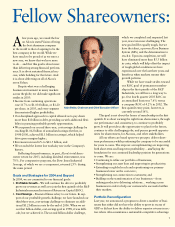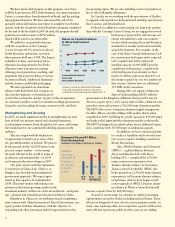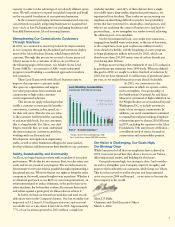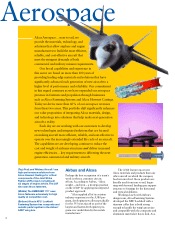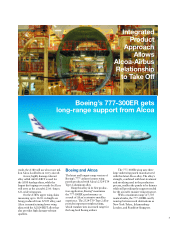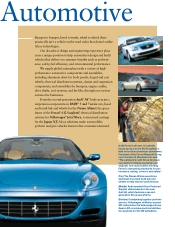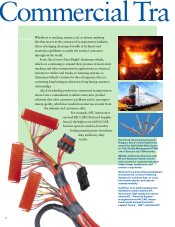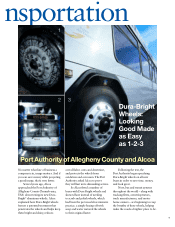Alcoa 2003 Annual Report Download - page 4
Download and view the complete annual report
Please find page 4 of the 2003 Alcoa annual report below. You can navigate through the pages in the report by either clicking on the pages listed below, or by using the keyword search tool below to find specific information within the annual report.
We have made solid progress on this program, as we have
sold the Latin America PET bottle business, our equity interest in
Latasa, a can producer based primarily in Brazil, and the packag-
ing equipment business. We have announced the sale of the
specialty chemicals business and expect to complete it in the first
quarter, with the remainder of this divestiture program completed
by the end of the first half of 2004. In total, the program should
generate proceeds in excess of $750 million,
which will be used to pay down debt.
We added to our portfolio this year
with the acquisition of the Camargo
Correa Group’s 40.9% interest in Alcoa’s
South American operations, a position
these partners held since 1984. The largest
subsidiary in these operations is Alcoa
Aluminio, headquartered in São Paulo.
Aluminio owns and operates mining,
refining, power generation, smelting, and
aluminum fabrication facilities at various
locations in Brazil. Additional businesses
include closures and flexible packaging.
We also expanded our aluminum
alliance with Kobe Steel Ltd. in Japan on
the joint development of aluminum prod-
ucts for the automotive market. As part of this arrangement,
we assumed complete control of aluminum rolling operations in
Australia, used in making beverage containers, foil, and sheet.
Strengthening and Growing
In 2003, we made significant strides in strengthening our asset
base in both our primary metals and alumina businesses,
accelerating movement down the global cost curve, and laying
the foundation for our continued leadership position in the
industry.
The year began with the finalization
of agreements to build a new, state-of-the-
art, greenfield smelter in Iceland. We plan to
break ground on this 322,000-metric-tons-
per-year (mtpy) smelter – to be among
the most efficient in the world in terms of
production and sustainability – in 2005
and expect production to begin in 2007.
Our joint venture with the Aluminum
Corporation of China, Ltd. (Chalco), at
Pingguo, has been delayed pending final
government approvals. We expect agree-
ments in this regard to be formalized in
2004. This joint venture will enhance our
position in the fastest-growing market in the
aluminum industry within one of the most efficient – and grow-
ing – alumina and aluminum production facilities in China.
Elsewhere in China, we are working toward completing a
joint venture with China International Trust & Investment, our
equity partner in Bohai Aluminum, with the objective of
expanding soft-alloy extrusions and foil opportunities in this
2
fast-growing region. We are also installing a new foil production
line at Alcoa Shanghai Aluminum.
In Canada, we are working with the government of Québec
to upgrade and expand our hydropowered smelting operations in
Baie-Comeau and Deschambault.
In Brazil, in addition to restructuring our long-term partner-
ship with the Camargo Correa Group, we are engaged in several
hydropower projects that will increase our
energy self-sufficiency and cost-competi-
tiveness while meeting Alcoa and Brazilian
standards for socially and environmentally
sound development. For example, in the
case of the Barra Grande hydropower facil-
ity, construction has begun and is expected
to be completed in 2006, with total
installed capacity of 690 MW. Upon the
completion of this project, coupled with
other hydropower investments we have
made, we will provide more than 40% of
the energy required for our two smelters in
that country. And we have an additional
355 MW under concession.
During 2003, we signed a Memoran-
dum of Understanding (MOU) with the
government of the Kingdom of Bahrain that paves the way for
Alcoa to acquire up to a 26% equity stake in Alba, a Bahrain com-
pany that owns and operates a 512,000-mtpy aluminum smelter.
The MOU also covers a long-term alumina supply arrangement
for Alba. Alba is currently adding a fifth potline which, when
completed in 2005, will bring its overall capacity to 819,000 mtpy
and make it the largest prebake aluminum smelter in the world.
The MOU is designed to accelerate plans for an additional expan-
sion, a sixth line with 307,000 mtpy of additional capacity.
In addition, we have announced plans
to conduct a feasibility study over the next
two years to explore building a smelter in
Brunei Darussalam.
Alcoa World Alumina and Chemicals
(AWAC) – a global alliance between
Alcoa and Alumina Ltd, with Alcoa
holding 60% – completed the 250,000-
mtpy construction expansion of its
Jamalco alumina refinery in Clarendon,
Jamaica ahead of schedule. AWAC also
broke ground on a 250,000-mtpy alumina
expansion at its Paranam alumina refinery
in Suriname. And we have begun an effi-
ciency upgrade at AWAC’s Pinjarra alumi-
na refinery in Western Australia that will
increase capacity there by 600,000 mtpy.
As part of our strategy, we continue to explore promising
opportunities across the world, including some in Russia. These
efforts are designed to lower Alcoa’s costs in primary metals – in
many cases replacing older, less competitive capacity with newer,
more efficient operations, while in other cases we are adding
Top Quintile S&P Industrials
Alcoa ROC
Alcoa Quarter Annualized
All indicators are based on the Bloomberg ROC Methodology.
1Q 03 Quarter Annualized ROC excludes $47 million after-tax
cumulative effect of accounting change due to adoption of FAS 143.
4Q 02 1Q 03 2Q 03 3Q 03 4Q 03
0
5
10
15
20
Return on Capital Continues
to Show Improvement
Percent
Continue to
reduce costs –
eliminate $1.2B
in costs on a
run-rate basis
by the end
of 2006
98-00 01-02 03
Goal 2001-2003 Goal
278 278 278
253
150
Surpassed Second $1 Billion
Cost-Savings Goal
Quarterly Run Rate in Millions of Dollars



